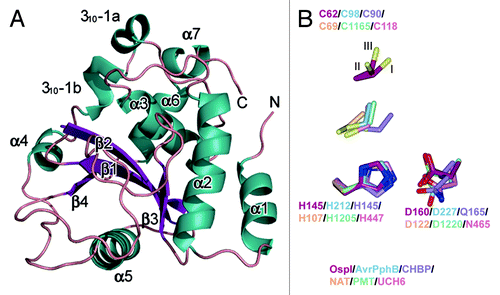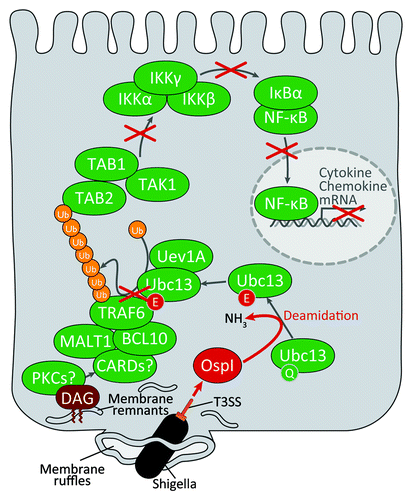Figures & data
Figure 1. Crystal structure of Shigella OspI. (A) Overall structure of Shigella OspI. The colors of the secondary structural elements indicate the following: dark green, α-helix; dark purple, β-strands; salmon, loops. (B) The alignments of the catalytic cores using the putative catalytic triad residues, all atoms of His, and the main chain atoms of Asp are shown as a reference. Dark red, Shigella OspI; light blue, AVRPphB (PDB ID code 1UKF); light purple, CHBP (Cif homolog from Burkholderia pseudomallei, PDB ID code 3GQM); orange, NAT (N-acetyltransferase, PDB ID code 1E2T); light green, PMT (Pasteurella multocida toxin, PDB ID code 2EBF); pink, UCH6 (ubiquitin C-terminal hydrolase 6, PDB ID code 1VJV). The C62 in OspI is represented in three alternate conformations with the three conformers labeled I, II and III.

Figure 2. Shigella inhibits acute inflammatory responses at the initial stage of infection. Shigella invades the host cell by macropinocytosis and quickly escapes from the phagosome into the cytoplasm. The phagosome membrane fragments are produced by Shigella upon escape in the host cytoplasm. DAG accumulates around the bacterial entry site. This accumulation activates the diacylglycerol-CBM complex-TRAF6-NFκB signaling pathway. Shigella OspI is delivered via the type III secretion system during bacterial invasion. OspI acts as a glutamine deamidase and selectively deamidates Gln100 to Glu100 in UBc13, severely impairing the E2 ubiquitin conjugating activity of Ubc13, which is required for the activation of the TRAF6-NFκB pathway.
